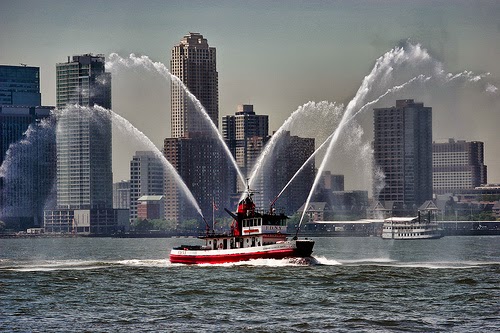by Christian Rowe
On my Central
Park exploration today, I noticed things that I would not have paid
much attention to before beginning my summer internship with LANDMARK WEST! The
first thing I noticed was that when you enter the park at 77th Street you walk
over a beautiful double arch bridge – and you don't even realize it. The
designers of the park strategically used nature to disguise man-made structures
throughout the park. I also discovered that the more you walk through the park
the more the scenery changes. The way Central Park
was designed, every few steps reveal something new to see while other features
disappear or reappear in different positions. To test this idea, I stood still
and take it all in and then took five steps in any direction to see what happened
– the scene definitely changed.
 |
| When you enter the park at 77th Street you walk
over a beautiful double arch bridge – and you don't even realize it! |
The
location for Central Park was chosen by the city because its natural topography
was too rocky to build houses on. One of the reasons why the city decided to
build a park may have been because we
had something to prove to Europeans who thought we only cared for our
individual selves instead of the greater public. The park was originally going
to be smaller, but the land was too rocky to end the park at 106th Street so they extended it to 110th Street. The
designers of the park were Frederick Law Olmsted and Calvert Vaux who won a
contest with their design. They had the winning design because theirs was the
most naturalistic and asymmetrical, which was the style of landscape design
that everyone wanted in the 1850s.
 |
| The Ramble Arch has gaps on the sides so it looks like some rocks fell off over
time, but at the same time the gaps give you a clear view when you look over
the edge. |
After
crossing the bridge at 77th Street
we walked to the Ramble, which is a part of Central Park
where the forestation gets really thick – it’s easy to get lost in there. Once
again the Ramble Arch was completely hidden until we were standing on top of
it. From the top the Ramble Arch looks like a natural rock bridge (besides its concrete
floor). It has gaps on the sides so it looks like some rocks fell off over
time, but at the same time the gaps give you a clear view when you look over
the edge. Looking at the Ramble Arch straight on, it sort of looks like you are
entering an ancient ruin in the jungle.
 |
| Looking at the Ramble Arch straight on, it sort of looks like you are
entering an ancient ruin in the jungle. |
My
favorite bridge in the park that I visited today was the Balcony
Bridge because it looks so peaceful. Aside
from the skyline and the people rowing boats you get the feel of being on a rock
looking out at a flowing river separating two parts of the jungle. Here at
Landmark West! we enjoy the privilege of having Central
Park in our city – you should too!
 |
| My
favorite bridge in the park that I visited today was the Balcony
Bridge because it looks so peaceful. |













